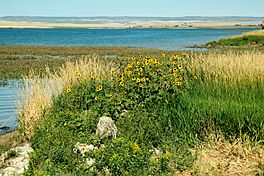McGregor Lake facts for kids
Quick facts for kids McGregor Lake |
|
|---|---|

East Bank
|
|
| Location | Vulcan County, Southern Alberta |
| Coordinates | 50°25′26″N 112°51′06″W / 50.42389°N 112.85167°W |
| Type | Reservoir |
| Primary inflows | Oldman River and Bow River (via canal) |
| Primary outflows | Bow River |
| Catchment area | 993 km2 (383 sq mi) |
| Basin countries | Canada |
| Max. length | 40 km (25 mi) |
| Max. width | 2 km (1.2 mi) |
| Surface area | 51.4 km2 (19.8 sq mi) |
| Average depth | 6.5 m (21 ft) |
| Max. depth | 9.7 m (32 ft) |
| Surface elevation | 868 m (2,848 ft) |
| Settlements | Milo |
McGregor Lake is a long, narrow reservoir (a human-made lake) in Southern Alberta. It's about 40 kilometers (25 miles) long and 2 kilometers (1.2 miles) wide. This lake was made in 1920 when two dams were finished in the Snake Valley. McGregor Lake is located about 100 kilometers (62 miles) southeast of Calgary in an area called Vulcan County.
The lake is part of a large water system called the Carseland-Bow River Headworks System. This system is managed by Alberta Environment and Parks. It helps deliver water to farms in the Bow River area for irrigation. Most of the water in McGregor Lake comes from the Bow River through special canals, even though the lake is in the Oldman River area. A British company called Canada Land and Irrigation Company built the lake. It was named after James Duncan McGregor, who was the company's Canadian manager. He later became a very important leader in Manitoba.
Contents
How McGregor Lake Was Made
The area where McGregor Lake is now was once a valley called Snake Valley. Long ago, members of the Blackfoot Confederacy (a group of First Nations people) traveled through this valley. European settlers started arriving in the mid-1800s.
By the 1880s, people were already raising cattle (ranching) in the valley. Soon after, more people came to live and farm there. The soil was rich, but the climate was dry, so farmers needed a way to get water to their crops. This led to the idea of building a large reservoir.
Construction on the reservoir began in 1909. Two dams were built: one in the north near Milo, Alberta, and another in the south. McGregor Lake was formed when these two dams, called the South and North McGregor dams, were completed by the Canada Land and Irrigation Company. Some water comes from the Oldman River, but a canal was also built to bring water from the Bow River. The whole project took ten years to build, and the reservoir started filling with water in 1920.
At first, a private company managed the lake. But in 1950, the Canadian government took over. They made changes to the dams to make them stronger. Then, in 1973, McGregor Lake and its dams were given to Alberta Environment, which still manages them today.
Fun Things to Do at McGregor Lake
McGregor Lake is a great place for outdoor activities! You can go swimming and boating at the McGregor Lake Recreation Area. This used to be called Milo Campground and is now an Alberta Provincial Park site. It has places to camp, a boat launch for boats, playgrounds for kids, and picnic areas. Smaller boats can also be launched at Lomond Crossing, where a road crosses the lake.
Fishing at the Lake
If you like fishing, McGregor Lake is a good spot. You can catch different types of fish here, including Walleye, Yellow Perch, Lake Whitefish, Rainbow Trout, and Northern Pike (also known as Jackfish). Sometimes, in October, you can even see lake whitefish laying their eggs near the sluice gate on the northwest side of the lake. People have reported catching very large northern pike, some weighing up to 10 kilograms (22 pounds)!
Water Activities and Wildlife
The water in McGregor Lake is usually clear and clean, which is great for swimming and other water sports. People enjoy picnicking, swimming, fishing, windsurfing, canoeing, water skiing, and power boating. In recent years, many cottages have been built on the east side of the lake near the village of Milo.
From April to September, you might see American white pelicans and double-crested cormorants looking for food on the lake. In spring and fall, many different kinds of waterfowl, like snow geese, Canada geese, and greater white-fronted geese, stop at the lake during their migrations. In spring and summer, you might spot blue-winged teals and northern shovelers. The dry grasslands around the lake are home to interesting birds like marbled godwits and long-billed curlews. You can also find unique prairie plants, such as the cushion cactus with its pretty burgundy flowers and the prickly pear cactus with its bright yellow blossoms, both of which bloom in June.
How McGregor Lake Helps People
McGregor Lake was built mainly to help farmers by providing water for their crops. In 2000, the lake held a lot of water, enough to water almost 200 square miles (518 square kilometers) of farmland. Farmers use this water to grow crops like alfalfa and clover for hay, as well as canola, corn, and other special crops.
People have also fished McGregor Lake for business since at least 1938, catching northern pike. Since about 1948, they have also commercially fished for lake whitefish. In the 1980s, commercial fishing brought in a lot of fish each year, which was worth a lot of money.
The area around McGregor Lake also has oil and gas. Many large energy companies work there. In 2007, a special training session was held at the lake to show how to clean up oil spills in water. Many workers from different companies attended to learn how to keep the lake safe from pollution.


